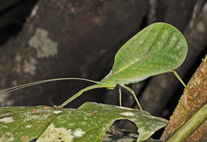Abstract
Amazophrynella is a taxonomically poorly known bufonid genus with a pan-Amazonian distribution. A large part of this ambiguity comes from taxonomic uncertainties regarding the type species A. minuta. In this study we compare morphological and molecular data of topotypic specimens of A. minuta with all other nomical congeneric species. Based on these comparisons, we describe two new species. The first species, A. amazonicola sp. nov., differs from other recognized congeners by having a tip of snout with a small triangular protrusion (in dorsal and lateral view), spiculated body and basal webbing on fingers I and II. The second species, A. matses sp. nov., differs from congeners by the smallest snout to vent length of the genus, edges of nasal protrusion dilated and elliptical shape palmar tubercles. The two species are allopatric, where the first species is known to be associated with white sand forests (=campinaranas), while the second inhabits upland (=terra firme) forests. Both species are diagnosable by a series of substitutions in the 16S rDNA, and both species are highly divergent from their sister taxa (p-distances range from 7–14%)

